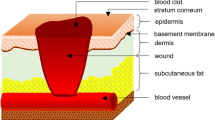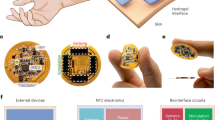Abstract
Ideally, all chronic wounds would be prevented as they can become life threatening complications. The concept that a wound produces a ‘current of injury’ due to the discontinuity in the electrical field of intact skin provides the basis for the concept that electrical stimulation (ES) may provide an effective treatment for chronic wounds. The optimal stimulation waveform parameters are unknown, limiting the reliability of achieving a successful clinical therapeutic outcome. In order to gain a more thorough understanding of ES for chronic wound therapy, systematic evaluation using a valid in vivo model is required. The focus of the current paper is development of the flexible modular surface stimulation (MSS) device by our group. This device can be programed to deliver a variety of clinically relevant stimulation paradigms and is essential to facilitate systematic in vivo studies. The MSS version 2.0 for small animal use provides all components of a single-channel, programmable current-controlled ES system within a lightweight, flexible, independently-powered portable device. Benchtop testing and validation indicates that custom electronics and control algorithms support the generation of high-voltage, low duty-cycle current pulses in a power-efficient manner, extending battery life and allowing ES therapy to be delivered for up to 7 days without needing to replace or disturb the wound dressing.






Similar content being viewed by others
Abbreviations
- η :
-
Voltage step-up efficiency
- ADC:
-
Analog-to-digital converter
- CNC:
-
Computer numerical control
- D :
-
Switch duty factor
- DC:
-
Direct current
- ES:
-
Electrical stimulation
- FDA:
-
Food and Drug Administration
- LCP:
-
Liquid crystal polymer
- MOSFET:
-
Metal–oxide–semiconductor field-effect transistor
- MSS:
-
Modular surface stimulation
- NHS:
-
National Health Service (UK)
- PCB:
-
Printed circuit board
- PWM:
-
Pulse-width modulated
- R FB :
-
Voltage divider resistance
- T :
-
Boost converter clock period
- US:
-
United States
- UK:
-
United Kingdom
- V BATT :
-
Battery voltage
- V OUT :
-
Output voltage
References
Assimacopoulos, D. Wound healing promotion by the use of negative electric current. Am. Surg. 34(6):423–431, 1968.
Aziz, Z., and K. Flemming. Electromagnetic therapy for treating pressure ulcers. Cochrane Database Syst. Rev. 12:CD002930, 2012.
Bergstrom, N., M. A. Bennett, C. E. Carlson, et al. Treatment of Pressure Ulcers. Clinical Practice Guideline, No. 15. Rockville, MD: US Department of Health and Human Services. Public Health Service, Agency for Health Care Policy and Research. AHCPR Publication No. 95-0652. December 1994.
Bogie, K. M., S. I. Reger, and S. P. Levine. Electrical stimulation for pressure sore prevention and wound healing. Assist. Technol. 12(1):50–66, 2000.
Butcher, M. How to use Posifect® bio-electric stimulation therapy in chronic wounds. Wound Essent. 2:186–193, 2007.
Cho, C. Y., and J. S. Lo. Dressing the part. Dermatol. Clin. 16(1):25–47, 1998.
Cullum, N., E. A. Nelson, K. Flemming, and T. Sheldon. Systematic reviews of wound care management: (5) beds; (6) compression; (7) laser therapy, therapeutic ultrasound, electrotherapy and electromagnetic therapy. Health Technol. Assess. 5(9):1–211, 2001.
Davies, D. J., R. J. Ward, and J. R. Heylings. Multi-species assessment of electrical resistance as a skin integrity marker for in vitro percutaneous absorption studies. Toxicol. In Vitro 18(3):351–358, 2004.
Dealey, C., J. Posnett, and A. Walker. The cost of pressure ulcers in the United Kingdom. J. Wound Care. 21(6):261–262, 264, 266, 2012.
European Pressure Ulcer Advisory Panel and National Pressure Ulcer Advisory Panel. Prevention and Treatment of Pressure Ulcers: Quick Reference Guide. Washington, DC: National Pressure Ulcer Advisory Panel, 2009.
Feedar, J. A., L. C. Kloth, and G. D. Gentzkow. Chronic dermal ulcer healing enhanced with monophasic pulsed electrical stimulation. Phys. Ther. 71(9):639–649, 1991.
Field, F. K., and M. D. Kerstein. Overview of wound healing in a moist environment. Am. J. Surg. 167(1A):2S–6S, 1994.
Gardner, S. E., R. A. Frantz, and F. L. Schmidt. Effect of electrical stimulation on chronic wound healing: a meta-analysis. Wound Repair Regen. 7(6):495–503, 1999.
Gist, S., I. Tio-Matos, S. Falzgraf, S. Cameron, and M. Beebe. Wound care in the geriatric client. Clin. Interv. Aging 4:269–287, 2009; ((Epub 2009 Jun 9)).
Graebert, J. K., M. K. Henzel, K. S. Honda, and K. M. Bogie. Systemic evaluation of electrical stimulation for ischemic wound therapy in a pre-clinical in vivo model. Adv. Wound Care 3(6):428–437, 2014.
Henzel, M. K., D. S. Howe, J. Graebert, and K. M. Bogie. Optimization of a rat ischemic wound model for evaluation of the effects of electrotherapy on wound healing. 22nd Annual Meeting of the Wound Healing Society SAWC-Spring/WHS Joint Meeting. Wound Repair and Regeneration, Vol. 20, p. A24, 2012.
Houghton, P. E., K. E. Campbell, C. H. Fraser, C. Harris, D. H. Keast, P. J. Potter, K. C. Hayes, and M. G. Woodbury. Electrical stimulation therapy increases rate of healing of pressure ulcers in community-dwelling people with spinal cord injury. Arch. Phys. Med. Rehabil. 91(5):669–678, 2010.
Kannon, G. A., and A. B. Garrett. Moist wound healing with occlusive dressings. A clinical review. Dermatol. Surg. 21(7):583–590, 1995.
Kloth, L. C. Electrical stimulation for wound healing: a review of evidence from in vitro studies, animal experiments, and clinical trials. Int. J. Low Extrem. Wounds. 4(1):23–44, 2005.
LGMedSupply LLC, “TENS Unit, EMS Unit, LG-TEC ELITE Combo TENS/Muscle Stimulator,” 11/02/2011. http://www.lgmedsupply.com/lgelteunandm.html. Accessed 05/09/2014.
Lukaski, H. C., and M. Moore. Bioelectrical impedance assessment of wound healing. J. Diabetes Sci. Technol. 6(1):209–212, 2012; ((Review)).
Markova, A., and E. N. Mostow. US skin disease assessment: ulcer and wound care. Dermatol Clin 30(1):107–111, 2012; ((ix)).
Metzger, S. Clinical and financial advantages of moist wound management. Home Healthc. Nurse 22(9):586–590, 2004.
National Coverage Determination (NCD) for Electrical Stimulation (ES) and Electromagnetic Therapy for the Treatment of Wounds (270.1). http://www.cms.hhs.gov/Transmittals/Downloads/R166CIM.pdf.
Never Events, SMDL #08-004 Centers for Medicare & Medicaid Services Department of Health & Human Services, 2008. Accessed 04/11/2014.
Nuccitelli, R. A role for endogenous electric fields in wound healing. Curr. Top. Dev. Biol. 58:1–26, 2003.
Pressman, A. I., et al. The boost switching regulator topology. In: Switching power supply design. New York: McGraw-Hill, pp. 31–40, 2009.
Rippon, M., P. Davies, and R. White. Taking the trauma out of wound care: the importance of undisturbed healing. J. Wound Care. 21(8):359–360, 362, 364–368, 2012.
Rodger, D. C., A. F. Fong, W. Li, H. Ameri, A. K. Ahuja, C. Gutierrez, I. Lavrov, H. Zhong, P. R. Menon, E. Meng, J. W. Burdick, R. R. Roy, V. R. Edgerton, J. D. Weiland, M. S. Humayun, and Y.-C. Tai. Flexible parylene-based multielectrode array technology for high-density neural stimulation and recording. Sens. Actuators B Chem. 32(2):449–460, 2008. doi:10.1016/j.snb.2007.10.069.
Werdin, F., M. Tennenhaus, H. Schaller, and H. Rennekampff. Evidence-based management strategies for treatment of chronic wounds. Eplasty 9:e19, 2009.
Acknowledgments
This work was supported in part by the US Department of Veterans Affairs Advanced Platform Technology Center of Excellence (APT Center). The authors would like to thank Dr. M. Kristi Henzel and Jennifer Graebert for proving valuable feedback on benchtop testing relevant to translational implementation.
Author information
Authors and Affiliations
Corresponding author
Additional information
Associate Editor Amit Gefen oversaw the review of this article.
Rights and permissions
About this article
Cite this article
Howe, D.S., Dunning, J., Zorman, C. et al. Development of an Integrated Surface Stimulation Device for Systematic Evaluation of Wound Electrotherapy. Ann Biomed Eng 43, 306–313 (2015). https://doi.org/10.1007/s10439-014-1134-1
Received:
Accepted:
Published:
Issue Date:
DOI: https://doi.org/10.1007/s10439-014-1134-1




